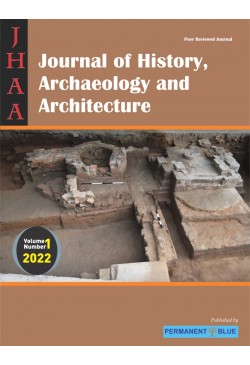
Journal of History, Archaeology and Architecture
Frequency :Bi-Annual
ISSN :2583-5106
Peer Reviewed Journal
Tracing the Ancient Trade route from Rājagṛiha to Tāmraliptī during the period of 3rd Century BCE to 6th Century CE
Jayasuriya, K.S. (2023). Tracing the Ancient Trade route from Rājagṛiha to Tāmraliptī during the period of 3rd Century BCE to 6th Century CE. Journal of History, Archaeology and Architecture, 2: 2, pp. 121-138.
Heritagization of Religious Festivals and (Re) Invention of Buddhist Heritage in Modern Sri Lanka
Indika, M.K.A. (2023). Heritagization of Religious Festivals and (Re) invention of Buddhist Heritage in Modern Sri Lanka. Journal of History, Archaeology and Architecture, 2: 2, pp. 139-145.
The Origins and Evolution of Sri Lankan Historiography
Rathanasa, K. (2023). The Origins and Evolution of Sri Lankan Historiography. Journal of History, Archaeology and Architecture, 2: 2, pp. 147-158.
Megalithic Monuments of Zeme Naga in Peren District, Nagaland
The present paper is an outcome of an ethnographic study conducted in the two Zeme villages old poilwa and old perenunder Peren district, which is located in the southern part of Nagaland. The study was undertaken to examine the typology of various stone monuments and their archaeological relevance, associated meanings, functions of the stone monuments and to examine the socio-economic formation of the Zeme pre-colonial society and to understand the location pattern of the stone monuments. The erection of Zeme monuments is associated with feast andvarious stages of feast held and the monuments erected are a result of competitive feasting activities and surplus economy of the community. However, there are indicative of recursive relations of mutual aid and solidarity among families, clan and khels being highly practiced among the Zemes. It is interesting to find out that almost all the megaliths are being erected in prominent places around the village vicinity or on their way to the field where it is widely visible by the passerby. The tradition of erecting monuments and the practice of megalithic culture has been an important tradition among the Zemes in the past and is still in practice albeit in smaller scale and in Christianized ways.
Lungalang, K. (2023). Megalithic Monuments of Zeme Naga in peren District, Nagaland. Journal of History, Archaeology and Architecture, 2: 2, pp. 159-172.
Origin and Authorship of Megalithic Culture in India
Kumar, V. & Kumar, R. (2023). Origin and Authorship of Megalithic Culture in India. Journal of History, Archaeology and Architecture, 2: 2, pp. 173-180.
Archaeological Findings and Socio- Economic Changes in Samba District (J&K): A Probe
Kumar, V. & Kumar, R. (2023). Origin and Authorship of Megalithic Culture in India. Journal of History, Archaeology and Architecture, 2: 2, pp. 181-188.
The Devaraja Cult of Kampuchea: A Different type of Tantric Shaiva Cult
Devaraja, in ancient Cambodia, the cult of the “god-king” established early in the 9th century ad by Jayivarman II, founder of the Khmer empire of Angkor. For centuries, the cult provided the religious basis of the royal authority of the Khmer kings. The devarāja cult grew out of both Hindu and indigenous traditions. Devarāja is the Hindu-Buddhist cult of deified royalty in Southeast Asia. It could be simply described as Southeast Asian concept of divine king. The concept viewed the monarch to possess transcendental quality, the king as the living god on earth, the incarnation of the supreme god, often attributed to Shiva or Vishnu. The concept is closely related to Indian concept of Chakravartin (universal monarch). In politics, it is viewed as the divine justification of a king’s rule. The concepts was institutionalized and gain its elaborate manifestations in ancient Java and Cambodia, where monuments such as Prambanan and Angkor Wat were erected to celebrate the king’s divine rule on earth.
Kumar, A. (2023). The Devaraja Cult of Kampuchea: A Different type of Tantric Shaiva Cult. Journal of History, Archaeology and Architecture, 2: 2, pp. 189-196.
History of Devadasi in Odisha: Special Reference to Sacred Prostitution
Bhuyan, R., & Pradhan, S. (2023). History of Devadasi in Odisha: Special Reference to Sacred Prostitution. Journal of History, Archaeology and Architecture, 2: 2, pp. 197-205.
Parvatadwarak: An Ancient Historic Site of Kalahandi
Routa, G. (2023). Parvatadwarak: An Ancient Historic Site of Kalahandi. Journal of History, Archaeology and Architecture, 2: 2, pp. 207-218.
Exploration of Buddhist Remains in Shivpuri: A Review
Dwivedi, P. (2023). Exploration of Buddhist Remains in Shivpuri: A Review. Journal of History, Archaeology and Architecture, 2: 2, pp. 219-226.
A Study on the Factors and the Implementation of the Zamindari System: Administration in Madras Presidency, British India
Shenbagavalli, S. (2023). A Study on the Factors and the Implementation of the Zamindari System: Administration in Madras Presidency, British India. Journal of History, Archaeology and Architecture, 2: 2, pp. 227-237.
Bimbisar and Shrenik: Connecting Mainstream and Jain History
Sanghavi, H. (2023). Bimbisar and Shrenik: Connecting Mainstream and Jain History. Journal of History, Archaeology and Architecture, 2: 2, pp. 239-241.
Remnants of Primaeval Forests in Some Parts of Uttar Pradesh
Singh, N. (2023). Remnants of Primaeval Forests in Some Parts of Uttar Pradesh. Journal of History, Archaeology and Architecture, 2: 2, pp. 243-253.
Buddhist Art in the Upper Beas and Sutlej Valleys
Kumari, S. (2023). Buddhist Art in the Upper Beas and Sutlej Valleys. Journal of History, Archaeology and Architecture, 2: 2, pp. 255-259.